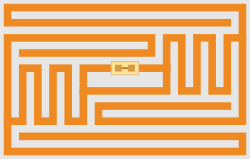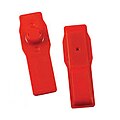Radio-frequency identification
Radio-frequency identification (RFID) is a technology used to record the presence of an object using radio signals. It is used for inventory control or timing sporting events. RFID is not a replacement for barcoding, but a complement for distant reading of codes. The technology is used for automatically identifying a person, a package or an item. To do this, it relies on RFID tags. These are small transponders (combined radio receiver and transmitter) that will transmit identity information over a short distance, when asked. The other piece to make use of RFID tags is an RFID tag reader.
An RFID tag is an object that can be applied to or incorporated into a product, animal, or person for the purpose of identification and tracking using radio waves. Some tags can be read from several meters away and beyond the line of sight of the reader. Most tags carry a plain text inscription and a barcode as complements for direct reading and for cases of any failure of radio frequency electronics.
Most RFID tags contain at least two parts. One is an integrated circuit for storing and processing information, modulating and de-modulating a radio-frequency (RF) signal, and other specialized functions. The second is an antenna for receiving and transmitting the signal.
There are generally two types of RFID tags: active RFID tags, which contain a battery, and passive RFID tags, which have no batteries
Uses
RFID systems are used for the following:
- General transport (logistics), tracking a package, parcel; replacing barcodes
- Tracking vehicles for road toll
- Many countries have started using RFID chips in passports
- Making products harder to falsify; currently proposed for drugs
- Tags in clothing, e.g. in Jeans
- Sealing for containers (for the shipping industry). Not required yet.
- Identifying animals; used for tracking pets, but also for research, for example on turtles.
- Keys for vehicles. The vehicle key has an RFID tag inside; only the key with the right RFID tag can start the vehicle (this makes copying vehicle keys harder). Also used for locking/unlocking vehicles from a far distance.
- Contact-less identity cards, for example to regulate entry into certain areas; also used for ticketing, or public transport
- Transponder timing of sporting events.
- Marking attendance of students
Radio-frequency Identification Media
FasTrak, an RFID tag used for electronic toll collection in California
Sewn-in RFID label in garment manufactured by the French sports supplier Decathlon. Front, back, and transparency scan.
A surgeon implants British scientist Dr Mark Gasson in his left hand with an RFID microchip (March 16, 2009).









